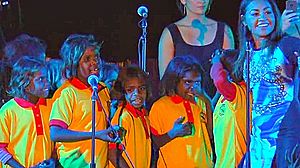Yorta Yorta language facts for kids
Quick facts for kids Yorta Yorta |
|
|---|---|
| Yotayota Murray–Goulburn |
|
| Region | Victoria, Australia |
| Ethnicity | Yorta Yorta (Pangerang, Kwatkwat) |
| Extinct | by 1960 |
| Language family |
Pama–Nyungan
|
| Dialects |
Yaliba-Yaliba
|
| AIATSIS | D2 |
The Yorta Yorta language, also known as Yotayota, is spoken by the Yorta Yorta people. They are Indigenous Australians who traditionally lived near where the Goulburn River and Murray River meet in northeast Victoria, Australia. Some experts think it might be a group of closely related languages rather than just different ways of speaking one language.
The Yorta Yorta language has many different spellings, like Jotijota, Yodayod, and Yoorta. Other names for it include Arramouro and Wol-lithiga. Different Yorta Yorta groups, called clans, include the Bangerang, Moira, and Kwat Kwat.
The Yaliba Yaliba language, spoken by the Pikkolaatpan tribe, is quite similar to the Bangerang way of speaking. About 70% of the words are the same. This suggests they might be separate but related languages.
Contents
The Yorta Yorta Language Today
The Yorta Yorta language was once considered "dormant." This means it was not actively spoken every day. This happened because of contact with Europeans and when people were forced to move to missions. However, the Yorta Yorta people have kept many words from their language alive. Today, there are strong efforts to bring the language back into everyday use. In 2021, 151 people said they spoke Yorta Yorta.
How is the Yorta Yorta Language Being Revived?
Two Yorta Yorta women, Lois Peeler and Sharon Atkinson, worked with Dr. Heather Bowe from Monash University. They spent several years gathering information about the language. Their work is called Yorta Yorta Language Heritage. This important book brings together all the written records and spoken examples of the language. It also includes lessons for learning Yorta Yorta. Plus, it has dictionaries to help people translate words between English and Yorta Yorta.
Sounds of the Yorta Yorta Language
Like all languages, Yorta Yorta has its own special sounds. These sounds are made using different parts of your mouth, like your lips, tongue, and throat.
Consonant Sounds
Consonants are sounds where the airflow from your lungs is blocked or partly blocked. Yorta Yorta has sounds similar to 'b', 'd', 'm', and 'n' in English. It also has some sounds that are made in different places in the mouth, like dental sounds (made with the tongue against the teeth) and palatal sounds (made with the tongue against the roof of the mouth).
Vowel Sounds
Vowels are sounds where the air flows freely from your lungs. Yorta Yorta has vowel sounds like 'i' (as in 'sit'), 'u' (as in 'put'), 'e' (as in 'bed'), 'o' (as in 'go'), and 'a' (as in 'father').
Music and the Yorta Yorta Language

The song "Ngarra Burra Ferra" is a famous example of the Yorta Yorta language in music. Jessica Mauboy, an Indigenous artist, sang this song in the 2012 movie The Sapphires. The song is based on an old Aboriginal hymn called "Bura Fera."
What Does "Ngarra Burra Ferra" Mean?
"Ngarra Burra Ferra" is sung in the Yorta Yorta language. It tells a story from the Bible about how God helped to defeat the armies of Pharaoh. The chorus, Ngara burra ferra yumini yala yala, means "The Lord God drowned all Pharaoh's armies, hallelujah!"
This song is connected to an ancient Jewish tradition. It's known as the "Song of the Sea" or "Miriam's Song." Miriam, the older sister of the prophet Moses, is said to have sung it. You can find this story in the book of Exodus 15 in the Bible. It talks about Pharaoh's chariots being drowned in the Red Sea. It's amazing that Aboriginal communities in Victoria and southern New South Wales might be the only people in the world who still sing this ancient song in the Yorta Yorta language!
See also
 In Spanish: Idioma yorta yorta para niños
In Spanish: Idioma yorta yorta para niños

